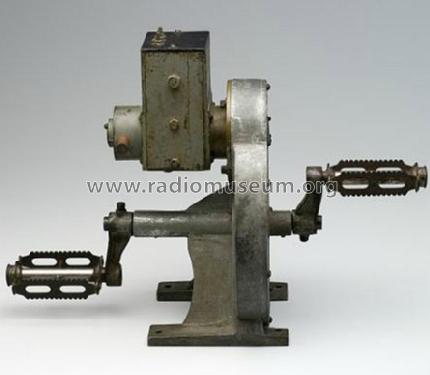Pedal Wireless Baby
Traeger Transceivers Pty. Ltd.; Adelaide
- Country
- Australia
- Manufacturer / Brand
- Traeger Transceivers Pty. Ltd.; Adelaide
- Year
- 1928
- Category
- Commercial Transmitter & Receiver (TRX not Amateur)
- Radiomuseum.org ID
- 275691
- Number of Tubes
- 3
- Main principle
- TRF (Tuned-Radio-Frequency but use of regeneration unknown)
- Wave bands
- Broadcast and Short Wave (SW).
- Power type and voltage
- Batteries / addl. power jack / 2 × 1.5 & 9 or 180 Volt
- Loudspeaker
- - only for Earphone!
- Material
- Wooden case
- from Radiomuseum.org
- Model: Pedal Wireless Baby - Traeger Transceivers Pty. Ltd.
- Shape
- Tablemodel, low profile (big size).
- Notes
-
Alf Taeger with help from Harry Kauper built the first Pedal Transceiver in 1928 and the first practical test took place in November. Six Pedal Wirelesses were built in 1929, for the Air Medical service, the predecessor to the Royal flying Doctor Service.
The transceiver used a B205 triode as a crystal oscillator, output stage with an RF output of 1.5 W.
It transmitted Morse code on a frequency of 2230 kHz. Morse was used because voice transmission was not practical at the time due to the higher power consumption required. Low power battery valves suitable for voice transmission did not become available till mid-1930’s.
The 2 valve regenerative receiver used two A141 tetrodes. The receiver covered the broadcast band up to approximately 4 MHz.
The filament supply was from two 1.5 V dry batteries and one 9 V battery. Treager developed a pedal generator to supply the B+ producing 180 V.
Silicon Chip magazine of November 2010 describes a replica of this radio built by John Sheard.
- Mentioned in
- Silicon Chip magazine, November 2010, Page 98
- Author
- Model page created by Gary Cowans. See "Data change" for further contributors.
- Other Models
-
Here you find 7 models, 6 with images and 1 with schematics for wireless sets etc. In French: TSF for Télégraphie sans fil.
All listed radios etc. from Traeger Transceivers Pty. Ltd.; Adelaide
Literature
The model Pedal Wireless is documented in the following literature.

